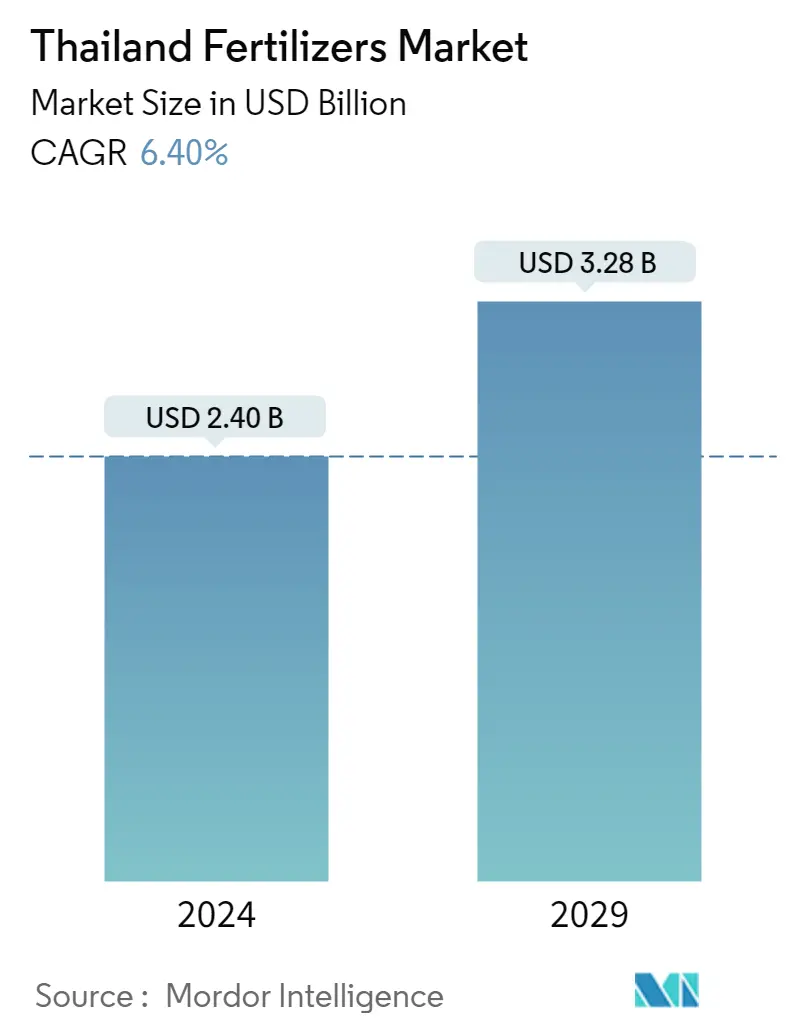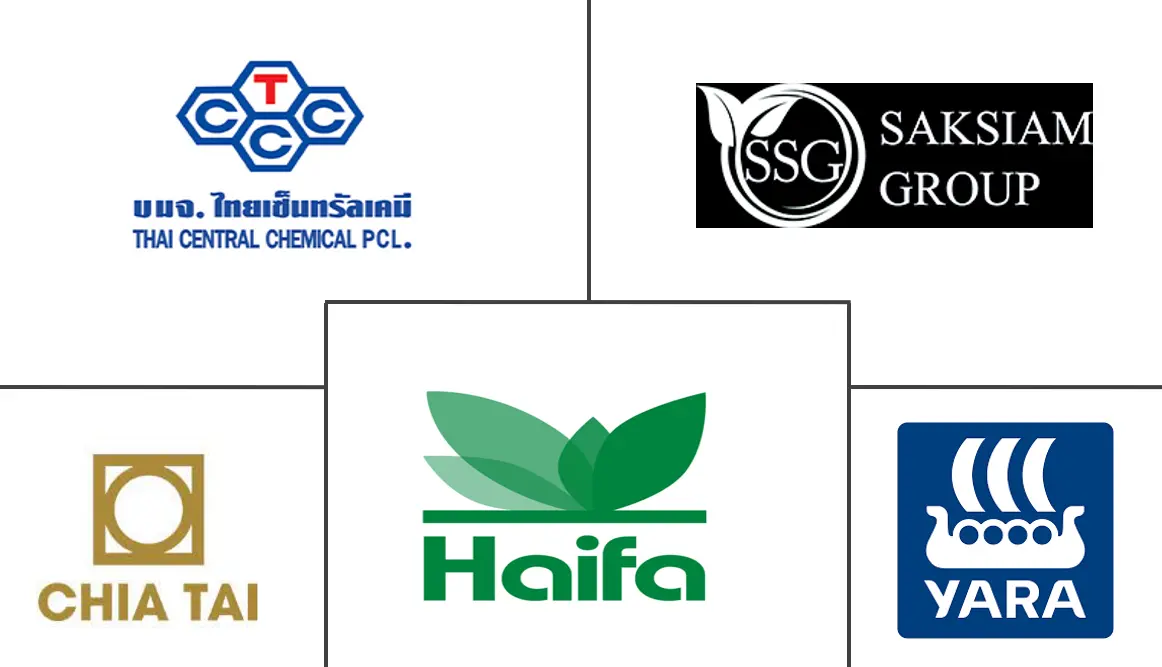Market Size of Thailand Fertilizers Industry

| Study Period | 2019 - 2029 |
| Base Year For Estimation | 2023 |
| Market Size (2024) | USD 2.40 Billion |
| Market Size (2029) | USD 3.28 Billion |
| CAGR (2024 - 2029) | 6.40 % |
| Market Concentration | Medium |
Major Players
*Disclaimer: Major Players sorted in no particular order |
Thailand Fertilizers Market Analysis
The Thailand Fertilizers Market size is estimated at USD 2.40 billion in 2024, and is expected to reach USD 3.28 billion by 2029, growing at a CAGR of 6.40% during the forecast period (2024-2029).
COVID-19 has a direct and negative impact on the value chain of the fertilizer market. The lockdown in Thailand has affected the transportation systems adversely. The primary raw materials used in the production of chemical fertilizers include ammonium, sulfuric acid, phosphorous, and potassium. The logistics restraints limited the supply of the raw material, and also, the prices of the fertilizers impacted the domestic fertilizer industry during the pandemic. Spike in fertilizer prices was also observed in 2020, owing to the logistics ban and increased international prices of phosphates and urea.
The increasing adoption rate of new technologies by farmers, increasing agricultural productivity, and growing country population are some of the major factors driving the Thailand fertilizer market. Additionally, the government has supported the farmers by providing them indirect intervention through fertilizer subsidy, i.e., cheap fertilizers and soft loans. For instance, in 2019, the government announced to launch new stimulus measures for the Thai farmers in the form of cheap fertilizers. This measure will be included on the state welfare smartcard, to provide subsidy directly to the card holders. It also announced a budget of TBH 60.36 billion (USD 1.98 billion) for three agricultural price subsidy programs for small rice and oil palm farmers in 2019. The rise in support provided to the farmers has led to the increased consumption of fertilizers, in order to increase the farm productivity. Similar trend is expected to be seen in the coming years.
Nitrogenous fertilizer dominates the market as the demand for notrogenous fertilizer is high owing to soil nitrogen deficient, due to the dominance of rice crops. Thus, nitrogenous fertilizers are the most frequently used, especially urea. For instance, according to IFASTAT, the nitrogenous fertilizer consumption in the form of Urea was 705.2 thousand metric ton in 2017. Despite the increasing area under organic cultivation in the country, the challenges in the usage of biofertilizers and organic fertilizers resulted in farmers to prefer synthetic or chemical fertilizers.
Thailand Fertilizers Industry Segmentation
According to OECD, chemical fertilizers are commercially produced, usually synthetic, chemical compounds, such as nitrogen, phosphorus, and potassium, as well as a variety of micronutrients and additives used in farming. . The Thailand fertilizers market is segmented by product (nitrogenous fertilizers, phosphatic fertilizers, potassic fertilizers, micronutrients fertilizers, and other products), and application (grains and cereals, pulses and oilseeds, commercial crops, fruits and vegetables, and other applications).
| Product | ||||||||
| ||||||||
| ||||||||
| Potash Fertilizers | ||||||||
| Micronutrient Fertilizers | ||||||||
| Other Products |
| Application | |
| Grains and Cereals | |
| Pulses and Oilseeds | |
| Commerical Crops | |
| Fruits and Vegetables | |
| Other Applications |
Thailand Fertilizers Market Size Summary
The Thailand fertilizers market is poised for significant growth over the forecast period, driven by factors such as the increasing adoption of advanced agricultural technologies, rising agricultural productivity, and a growing population. The government's supportive measures, including subsidies and financial assistance for farmers, have further bolstered the demand for fertilizers. Despite challenges posed by the COVID-19 pandemic, which disrupted supply chains and increased raw material costs, the market has shown resilience. Nitrogenous fertilizers, particularly urea, dominate the market due to the nitrogen deficiency in the soil, largely attributed to the prevalence of rice cultivation. The government's initiatives to enhance agricultural output, coupled with the strategic import of raw materials, are expected to sustain the market's growth trajectory.
The market landscape is moderately consolidated, with key players like Yara (Thailand) Company Limited, Thai Central Chemical Public Company Limited, and Chai Tai Co. Ltd actively engaging in mergers, acquisitions, and product innovations to strengthen their market position. The introduction of technology-driven solutions, such as Yara's 'Kaset Go' app, highlights the industry's shift towards integrating modern agricultural practices to improve crop yields. The demand for nitrogen fertilizers is anticipated to rise, supported by the country's reliance on key crops such as corn, cassava, and sugarcane. As Thailand continues to navigate the challenges of limited arable land and the need for increased agricultural exports, the fertilizers market is expected to expand, driven by both domestic consumption and strategic imports.
Thailand Fertilizers Market Size - Table of Contents
-
1. MARKET DYNAMICS
-
1.1 Market Overview
-
1.2 Market Drivers
-
1.3 Market Restraints
-
1.4 Porter's Five Forces Analysis
-
1.4.1 Bargaining Power of Buyers
-
1.4.2 Bargaining Power of Suppliers
-
1.4.3 Threat of New Entrants
-
1.4.4 Threat of Substitute Products
-
1.4.5 Intensity of Competitive Rivalry
-
-
-
2. MARKET SEGMENTATION
-
2.1 Product
-
2.1.1 Nitrogenous Fertilizers
-
2.1.1.1 Urea
-
2.1.1.2 Calcium Ammonium Nitrate (CAN)
-
2.1.1.3 Ammonium Nitrate
-
2.1.1.4 Ammonium Sulfate
-
2.1.1.5 Anhydrous Ammonia
-
2.1.1.6 Other Nitrogenous Fertilizers
-
-
2.1.2 Phosphatic Fertilizers
-
2.1.2.1 Mono-Ammonium Phosphate (MAP)
-
2.1.2.2 Di-Ammonium Phosphate (DAP)
-
2.1.2.3 Triple Superphosphate (TSP)
-
2.1.2.4 Other Phosphatic Fertilizers
-
-
2.1.3 Potash Fertilizers
-
2.1.4 Micronutrient Fertilizers
-
2.1.5 Other Products
-
-
2.2 Application
-
2.2.1 Grains and Cereals
-
2.2.2 Pulses and Oilseeds
-
2.2.3 Commerical Crops
-
2.2.4 Fruits and Vegetables
-
2.2.5 Other Applications
-
-
Thailand Fertilizers Market Size FAQs
How big is the Thailand Fertilizers Market?
The Thailand Fertilizers Market size is expected to reach USD 2.40 billion in 2024 and grow at a CAGR of 6.40% to reach USD 3.28 billion by 2029.
What is the current Thailand Fertilizers Market size?
In 2024, the Thailand Fertilizers Market size is expected to reach USD 2.40 billion.

